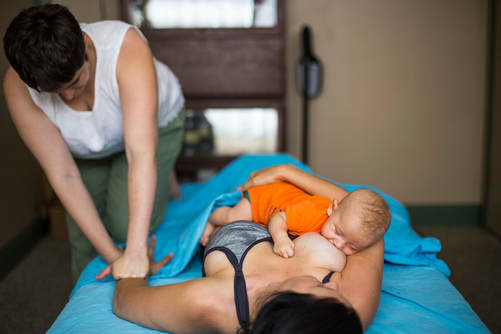Bodywork for Mothers and Babies

Massage: $60/hour
Postpartum Rolfing Session: $90/1.5 hours
Bodywork for babies: Free!
Our bodies are transformed by the experience of having a baby. While some changes last the duration (stretch marks), others ebb away with time and gradually our body returns to some version of its previous self.
However, certain changes may linger; diastasis recti (separation of the superficial rectus abdominis muscle down the middle of the abdomen), pelvic floor weakness or pelvic floor, hip and inner thigh pain such as from pubic symphysis dysfunction.
As your baby grows, other things show up now that life is changed by this other being you are care-taking; A hiked hip on the side you carry your baby or an internally rotated shoulder on the side you prefer for breastfeeding or wrist pain from carrying/breastfeeding.
While all of these issues are varied, the thing they have in common is that they are structural concerns and structural problems do not tend to respond well to spot-treatments. They heal bets when addressed globally, which is exactly what Structural Integration is designed to do.
Rolfing®, Structural Integration® is a method of deep manipulation of the connective tissues of the body, developed by Dr. Ida P. Rolf. Her intention was to create a system of postural restructuring and movement re-patterning, in order to promote ease and balance in the body and therefore the mind. Due to physical and emotional trauma, repetitive movements, and habits of standing, sitting and moving, our bodies can develop dysfunctional and characteristic patterns of strain. Rotations in bones, shortness, tightness, or too much laxity in related muscles and other tissues, and asymmetries within the body as a whole, create conflicting tensional forces. These may ultimately lead to sub-optimal choices in movement. Over time, and with repetition, these patterns can worsen, leading to further limitations in the body-mind. This dynamic is among the root causes of pain, discomfort, and other types of limitation including emotional and behavioral issues.
Postpartum Rolfing Session: $90/1.5 hours
Bodywork for babies: Free!
Our bodies are transformed by the experience of having a baby. While some changes last the duration (stretch marks), others ebb away with time and gradually our body returns to some version of its previous self.
However, certain changes may linger; diastasis recti (separation of the superficial rectus abdominis muscle down the middle of the abdomen), pelvic floor weakness or pelvic floor, hip and inner thigh pain such as from pubic symphysis dysfunction.
As your baby grows, other things show up now that life is changed by this other being you are care-taking; A hiked hip on the side you carry your baby or an internally rotated shoulder on the side you prefer for breastfeeding or wrist pain from carrying/breastfeeding.
While all of these issues are varied, the thing they have in common is that they are structural concerns and structural problems do not tend to respond well to spot-treatments. They heal bets when addressed globally, which is exactly what Structural Integration is designed to do.
Rolfing®, Structural Integration® is a method of deep manipulation of the connective tissues of the body, developed by Dr. Ida P. Rolf. Her intention was to create a system of postural restructuring and movement re-patterning, in order to promote ease and balance in the body and therefore the mind. Due to physical and emotional trauma, repetitive movements, and habits of standing, sitting and moving, our bodies can develop dysfunctional and characteristic patterns of strain. Rotations in bones, shortness, tightness, or too much laxity in related muscles and other tissues, and asymmetries within the body as a whole, create conflicting tensional forces. These may ultimately lead to sub-optimal choices in movement. Over time, and with repetition, these patterns can worsen, leading to further limitations in the body-mind. This dynamic is among the root causes of pain, discomfort, and other types of limitation including emotional and behavioral issues.